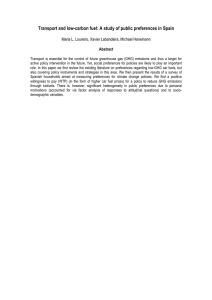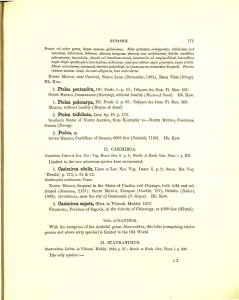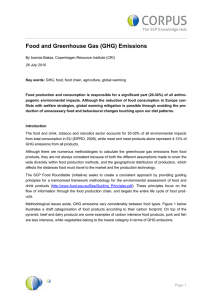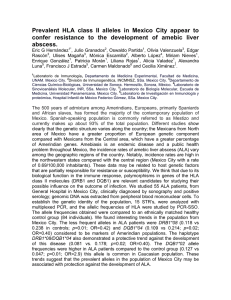Executive summary - Instituto Nacional de Ecología
Anuncio
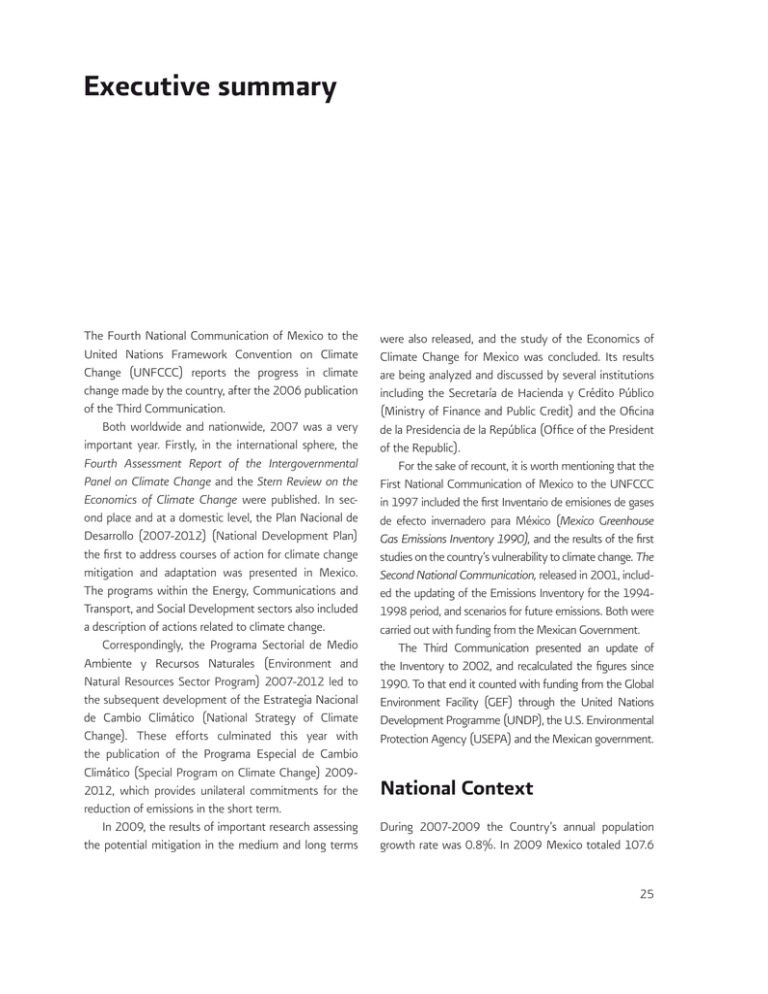
Executive summary The Fourth National Communication of Mexico to the United Nations Framework Convention on Climate Change (unfccc) reports the progress in climate change made by the country, after the 2006 publication of the Third Communication. Both worldwide and nationwide, 2007 was a very important year. Firstly, in the international sphere, the Fourth Assessment Report of the Intergovernmental Panel on Climate Change and the Stern Review on the Economics of Climate Change were published. In second place and at a domestic level, the Plan Nacional de Desarrollo (2007-2012) (National Development Plan) the first to address courses of action for climate change mitigation and adaptation was presented in Mexico. The programs within the Energy, Communications and Transport, and Social Development sectors also included a description of actions related to climate change. Correspondingly, the Programa Sectorial de Medio Ambiente y Recursos Naturales (Environment and Natural Resources Sector Program) 2007-2012 led to the subsequent development of the Estrategia Nacional de Cambio Climático (National Strategy of Climate Change). These efforts culminated this year with the publication of the Programa Especial de Cambio Climático (Special Program on Climate Change) 20092012, which provides unilateral commitments for the reduction of emissions in the short term. In 2009, the results of important research assessing the potential mitigation in the medium and long terms were also released, and the study of the Economics of Climate Change for Mexico was concluded. Its results are being analyzed and discussed by several institutions including the Secretaría de Hacienda y Crédito Público (Ministry of Finance and Public Credit) and the Oficina de la Presidencia de la República (Office of the President of the Republic). For the sake of recount, it is worth mentioning that the First National Communication of Mexico to the unfccc in 1997 included the first Inventario de emisiones de gases de efecto invernadero para México (Mexico Greenhouse Gas Emissions Inventory 1990), and the results of the first studies on the country’s vulnerability to climate change. The Second National Communication, released in 2001, included the updating of the Emissions Inventory for the 19941998 period, and scenarios for future emissions. Both were carried out with funding from the Mexican Government. The Third Communication presented an update of the Inventory to 2002, and recalculated the figures since 1990. To that end it counted with funding from the Global Environment Facility (gef) through the United Nations Development Programme (undp), the U.S. Environmental Protection Agency (usepa) and the Mexican government. National Context During 2007-2009 the Country’s annual population growth rate was 0.8%. In 2009 Mexico totaled 107.6 25 million people, of which 72.3% lived in urban zones and 27.7% in rural areas. An estimated 47.4% of the total population lived in patrimony poverty, and 60.8% of all the poor lived in rural areas, while 39.2% lived in urban zones. Mexico reported a Human Development Index (hdi) of 0.842 in 2006, which ranked the country in the 51st place out of 179 countries. In 2008 the primary energy production of the country was 10,500.2 petajoules (PJ), 0.2% less than in 2007. Although Mexico has renewable resources, their contribution to the primary energy production was only 7.7%. Hydrocarbons contribute 89.1%; hydro, 3.7%; firewood, 2.3%; coal, 2.2%; nuclear, 1.0%; sugarcane bagasse, 0.9%; geothermal, 0.7%, and wind, >0.2%. Each inhabitant consumed 79.5 kJ on average, which represents a 2.6% increase from the previous year. The final total energy consumption was 8,555.2 PJ. The sector that consumed more energy was transport with 47.6%, followed by the industrial sector with 26.3%, and the housing, commercial and public sectors with 17.7%. The requested energy sources were gasoline, 32%; diesel, 16%; electricity, 13%; dry gas, 11%; LP gas, 8.9%, and firewood 4.8%. Renewable energy sources such as hydroelectric, geothermal and wind power represent 21% of the installed capacity to generate electricity in the Country. Due to its natural capital Mexico ranks second place in ecosystem types and fourth in abundance of species worldwide. Its geographical location, variety of climates and topography, among other factors, accounts for these positions. However, the country is not exempt from degradation processes and loss of both terrestrial and marine ecosystems, which have shown symptoms of an anthropogenic impact for centuries, particularly serious during the last half century. Direct causes of biodiversity loss are deforestation, overexploitation and ecosystem contamination, as well as the introduction of invasive species and climate change. 26 México Cuarta Comunicación Nacional National Emissions Inventory 1990-2006 The updating of the National Greenhouse Gas Emissions Inventory (INEGEI) for 2006 was carried out with the Intergovernmental Panel on Climate Change (ipcc) methodologies and its Good Practice Guidelines in estimating emissions for the 1990 to 2006 period, for six greenhouse gases listed in Annex A of the Kyoto Protocol. In 2006, emissions in units of carbon dioxide in equivalents (CO2 eq) for Mexico were 709,005 Gg. The contribution by category in terms of CO2 eq is as follows: energy uses: 60.7% (430,097 Gg); waste: 14.1% (99,627.5 Gg); land use, land-use change and forestry: 9.9% (70,202.8 Gg); industrial processes: 9% (3,526 Gg); and agriculture: 6.4% (45,552.1 Gg). In turn, the energy uses category is subdivided as comes next: energy industry: 35% (49,137 Gg); followed by transportation: 34% (144,691 Gg); manufacturing and construction industry: 13% (56,832 Gg); fugitive emissions: 11% (47,395 Gg); and other sectors (residential, commercial and agricultural): 7% (32,042 Gg). ghg emissions by gas, measured in CO2 eq are: CO2, 492,862.2 Gg (69.5%); CH4, 185,390.9 Gg (26.1%); N2O, 20,511.7 Gg (2.9%), and the remaining 1.4% is made up of 9,586.4 Gg of HFCs, and 654.1 Gg of SF6. In 2003, the country stopped producing aluminum, so PFCs emissions are zero since 2004. The results of ghg for the years 1990-2006 show that the increase of ghg emissions was approximately 40% during that period, an average annual growth of 2.1%. Institutional Arrangements Since its foundation in 2005, the Comisión Intersecretarial de Cambio Climático (cicc, Inter-ministerial Commission on Climate Change), has been coordinating the activities of the Federal Public Administration in charge of formulating and implementing national policies for prevention and mitigation of ghg emissions, and for adaptation to climate change impacts. In order to put into practice the climate change agenda, the Secretaría de Medio Ambiente y Recursos Naturales (semarnat, Environment and Natural Resources Ministry) counts with: the Subsecretaría de Planeación y Política Ambiental (Planning and Environmental Policy Undersecretary) which guides policies and promotes projects for the Clean Development Mechanism; the Unidad Coordinadora de Asuntos Internacionales (Coordinating Unit for International Affairs), which monitors environmental agreements signed by Mexico, and the Instituto Nacional de Ecología (ine, National Institute of Ecology) which conducts research on mitigation and adaptation, puts together the National Greenhouse Gas Inventory and the National Communications of Mexico. To strengthen international negotiations, the Secretaría de Relaciones Exteriores (sre, Ministry of Foreign Affairs), is working in coordination with several ministries. Due to the importance of this issue, the Foreign Ministry has appointed a Special Ambassador for Climate Change who actively participates in negotiation meetings. Adaptation to Climate Change It is important to understand adaptation as the reduction of risks posed by climate change on people’s lifestyles, natural resources, environmental services, and productive and economic activities, through vulnerability reduction. In the coordination of disaster risk management and climate change adaptation, Mexico has recognized land planning and ecological zoning as means to reduce risk. Vulnerability to certain climate change impacts can be significantly reduced with appropriate ecosystem conservation and adequate watershed management. Relevant actions carried out by the Mexican Government: • Advise federal entities and municipalities to take into consideration adaptation concepts in their planning strategies and land zoning. • Promote the incorporation of references of climate change for disaster prevention and risk reduction measures derivative of the existing Atlas of Risks and or Hazards. • Upgrade Urban Development Programs, so they take risks and population vulnerability into account, and issue recommendations in order to be well-prepared for droughts, floods, extreme climatic events, and sea level rise, in a context of climate change. • Formulate strategies for fire prevention and control, and consider climate change for reforestation strategies. Governance and financial protection are tools of risk transfer and insurance, which are increasingly important for disaster prevention and management, including those of meteorological and climate origin. Such is the case of insurance and funds to secure housing, agricultural production, and businesses. Funds have been secured to assist emergencies and reduce risk, natural disasters and respond to climatic hazards. In the last three years studies on impacts, vulnerability and adaptation to climate change have been carried out. Special attention has been given to the construction of scenarios that incorporate expected changes in temperature and precipitation and their impacts due to a decrease of water availability, and agricultural productivity, and their effects on human health, biodiversity and forest ecosystems. • Among the relevant results of these investigations the following stand out: the critical situation in some states due to lack of water; increase in distribution areas and number of dengue cases, as well as the gradual reduction of biodiversity in large areas of central and northern Mexico. Mitigation Mexico acknowledges the importance of undertaking actions that contribute to the efforts of the international community in matters of ghg emissions mitigation. In this regard, the Mexican Government put into force the Programa Especial de Cambio Climático 2009-2012 (pecc, Special Program on Climate Change), through Executive Summary 27 which it seeks to demonstrate that ghg emissions mitigation is possible without jeopardizing development. Compliance to pecc at the end of the current administration will result in a reduction of 50 million tonnes of CO2 eq in 2012. This means a 6% deviation from the baseline estimate for the former year (786 million tonnes (metric tonnes) of CO2 eq), as consequence of the implementation of a series of unilateral actions in sectors such as energy generation and use, agriculture, forestry and other land uses, and waste. In a long-term vision, pecc establishes, as an aspirational goal, to reduce 50% of ghg emissions by 2050, as compared to 2000 levels, and a flexible convergence towards a global per capita emissions average of 2.8 tonnes of CO2 eq in 2050. The former, preconditioned to the availability of sufficient incentives and international support, as part of the new financial architecture which will be put into practice starting from the 15th Conference of the Parties that will take place in Copenhagen, in December 2009. Mitigation in the Energy Sector Important to highlight is that during the 1990-2006 period, the Country’s gdp grew at an average annual rate of 3%, while ghg emissions grew 2% and national population 1.5% per year. Despite the increase in emissions between 1990 and 2006, because of increased fossil fuel consumption, these have grown at a slower rate than the economy, so there are signs of a decoupling between economic growth and ghg emissions. With the implementation of various energy saving programs in industrial, commercial and public services, a saving of 15.7 million barrels of oil equivalent was obtained during the 2006-2008 period, preventing the emission of 8.6 million tonnes of CO2 eq. With the Programa de Horario de Verano (Daylight Savings Program), emissions decreased by 4.5 million tonnes of CO2 for the period 2006-2008. Since the implementation of the program to date (1996-2008), the installation of 799 MW of electricity generation capacity and the emission of 20.5 million tonnes of CO2 was prevented. 28 México Cuarta Comunicación Nacional Energy Efficiency In 2008, 18 Mexican Official Standards (NOMs) were applied, 16 of which are associated with electricity consumption and two with thermal processes. With the first 16, savings equivalent to 15,775 GWh with energy saving of 56.79 PJ were obtained, and emissions of 12.8 million tonnes of CO2 eq were avoided. Similarly, with the implementation of thermal efficiency standards, savings of 6 million barrels of oil equivalent, representing a consumption of 35.16 PJ, were achieved, and 1.97 million tonnes of CO2 eq were not emitted. As a result of energy efficiency measures, preliminary figures for the first half of 2009 show savings of 12,558 GWh, equivalent to 10.2 million tonnes of CO2. This figure considers actions of energy efficiency standardization, those made in industrial, commercial and public services, Daylight Savings Program and in the residential sector. Renewable energies The Programa Especial para el Aprovechamiento de Energías Renovables (Special Program for the Use of Renewable Energies) was published in 2009; it comes through as a mandate of the new Ley para el Aprovechamiento de Energias Renovables y el Financiamiento de la Transición Energética (Law for the Use of Renewable Energies and the Energy Transition Funding). The purpose of this law and its regulations is to promote the use of renewable energies, with specific objectives, goals and actions to achieve them. Mitigation in the residential sector In the residential sector, efforts have been oriented towards incorporating efficient technologies in matters of energy. The Programa de Vivienda Sustentable (Program for Sustainable Housing) was published in 2007; it proposes, among other actions, to adapt current regulations on housing towards environmental protection, and to create tax incentive schemes for housing developers and users. In 2008 the cooperation agreement between the Ministry of Energy, semarnat and the National Housing Commission was signed in order to coordinate the implementation of the Programa Transversal de Vivienda Sustentable (Sustainable Housing Cross-cutting Program), which seeks to change the perception and construction practices for housing in Mexico. According to the goals set by the Mexican Government, between 2007 and 2012, six million housing credits will be granted, of which approximately 20% should be used for sustainable housing. The Alliance to Save Energy (ase) granted the “International Award for Energy Saving in Sustainable Housing,” to honor Mexican Government efforts. The latter was received by the President of Mexico, Mr. Felipe Calderón Hinojosa, on September 23, 2009. Forestry, Agriculture and Livestock Mitigation During the 2007-2009 period, a budget of more than 1.3 billion dollars was allocated to the Programa ProÁrbol (Program for Reforestation); it has been applied to support payment schemes for environmental services for the conservation and development of community forestry, for the establishment of commercial forest plantations, for protecting forests against fires, pests and diseases, for ecosystem restoration and to increase competitiveness in forestry activities. The Comisión Nacional Forestal, CONAFOR (National Forestry Commission) aims to mitigate ghg emissions, increase forest carbon sinks potential, stabilize the forestagriculture border, and reduce the incidence of forest fires. In PECC, mitigation in the forestry sector is focused mainly on the incorporation of about 3 million hectares for sustainable forest management; the installation of 600,000 efficient wood stoves; to incorporate 2.5 million hectares of terrestrial ecosystems to the Sistema de Unidades de Manejo para la Conservación de la Vida Silvestre (umas, System of Wildlife Conservation and Management Units); to add 750,000 hectares of forest ecosystems to the status of Protected Natural Areas, and to introduce planned sustainable grazing practices in 5 million hectares. Complementarily, the Comisión Nacional de Áreas Naturales Protegidas (conanp National Commission of Natural Protected Areas), began developing its Estrategia de Cambio Climático y Áreas Protegidas (Climate Change and Protected Areas Strategy), launched its Fire Management Program in Protected Areas of Mexico, and has identified some pilot sites in protected areas in order to participate in the carbon market in the future. On the other hand, the Comisión Nacional para el Conocimiento y Uso de la Biodiversidad (conabio, National Commission for Knowledge and Use of Biodiversity) is also expanding its activities on climate change. Among other actions, it has a monitoring program in mangroves and mountain cloud forests, and continues working on its program of early detection of hot spots for appropriate care and firefighting. Among the mitigation actions performed in the agricultural sector, the following can be highlighted: land conservation and productive reconvertion; green harvesting of sugar cane to promote renewable energy use and development, rehabilitation and conservation of land grazing. Actions for ghg mitigation reported in the livestock sector are located in two areas. The first is related to the conservation and recovery of vegetation in grazing areas, and the second is focused on capture and use of methane from livestock farms, through the establishment of biogas digesters. The issue of biofuels has become increasingly important in Mexico. This can be confirmed with the publication of the Ley de Promoción y Desarrollo de los Bioenergéticos (Law for the Promotion and Development of Bioenergy), in February 2008, and its Regulations in June 2009. The Secretaría de Energía (sener, Ministry of Energy) and the Secretaría de Agricultura, Ganadería, Desarrollo Rural, Pesca y Alimentación (sagarpa, Ministry of Agriculture, Livestock, Rural Development, Fisheries and Food) are developing bioenergy programs that include environmental criteria and guidelines to be developed by semarnat to ensure that biofuels produced and used in Mexico are sustainable. Executive Summary 29 Projects under the Clean Development Mechanism Between September 2008 and August 2009, Mexico obtained the register of 12 projects by the Executive Board of the Clean Development Mechanism (cdm) of the Kyoto Protocol. This gave a total of 118 registered projects, of which 20 received Certified Emission Reductions (CERs). In doing so, the mitigated and cdm registered tonnes of CO2 eq rose to 53%, going from 3.8 to 5.8 million tonnes cumulatively. In the same period the CICC granted letters of approval to 22 projects, with which the cumulative number amounted to 217 by August of 2009. Internationally, Mexico participates with 7% of cdm projects, was ranked 4th place for the amount of registered projects, 5th for the expected CERs volumes, and is the 5th Country in terms of CERs obtained. Emissions Scenarios of Greenhouse Gases for 2020, 2050 and 2070 In 2009, ine financed and coordinated the “Study on the Impact of Renewable Energy Sources of ghg Emissions in Mexico in the Medium and Long Terms”, carried out by the Instituto de Investigaciones Eléctricas (Electric Power Research Institute) and the study “ ghg Emissions Scenarios in the Medium and Long Terms, 2020, 2050 and 2070”, prepared by the Instituto Mexicano del Petróleo (Mexican Institute of Petroleum). These studies will be useful to estimate the national baseline of ghg emissions for the medium (2020) and long (2050) terms. Other relevant studies on mitigation published in the last two years are: a) Study on the Economics of Climate Change in Mexico, coordinated by semarnat and the Ministry of Finance, with financial support from the UK Government and the Inter-American Development Bank; 30 México Cuarta Comunicación Nacional b) Low-Carbon Growth. A potential Path for Mexico, conducted by the Mario Molina Center and the McKinsey consulting firm; c) Low-Carbon Development for Mexico (medec), developed with funding and technical assistance of: The World Bank; d) Climate Change in Mexico and Potential Emission Reduction by Sectors, conducted by a consultant. Other Relevant Information Since 2007, technical specialists and scientists from most of the 32 Mexican States began training for the preparation of their Programas Estatales de Acción ante el Cambio Climático (peacc, State Program for Climate Change Action). So far, the state of Veracruz and the Federal District have completed the formulation of their programs, and Nuevo Leon, Baja California, Baja California Sur, Guanajuato, Coahuila and Puebla are in process, while those in Chiapas, Tabasco and Michoacan are in the planning process, and the State of Mexico is developing the Iniciativa ante el Cambio Climático (Initiative for Climate Change); in addition, the municipality of Chihuahua, in the state of Chihuahua presented its Climate Action Plan in September, 2009. Future Actions The research needs identified after several diagnostic exercises are grouped into five categories: 1) national inventory of emissions of greenhouse gases, 2) monitoring, reporting and scenarios, 3) impacts, vulnerability and adaptation, 4) mitigation of greenhouse gases, and 5) economic, legal and international studies. In order to improve the next inventories it is necessary to continue conducting research to determine national emission factors for key sources, and to analyze in depth the differences between the reference and the sectorial approach. On the other hand, it is necessary to look deeper into observation activities; to continue building and refining models under different climate change scenarios; as well as to continue putting together and publishing various risk atlas; one would be the first National Atlas of Vulnerability to Climate Change, and to continue with diverse mapping, for example, mapping for morbidity and mortality associated with increased health risks due to climate change. For a more efficient management of mitigation options in the Country, it is necessary to continue a more in depth evaluation of the mitigation potential of various technology options, for key emitting sectors. Furthermore, it becomes necessary to develop emis- sions mitigation frameworks to measure, report and verify them in strategic sectors, particularly the definition of Nationally Appropriate Mitigation Actions (namas). The need for better estimates on the potential economic and financial costs of climate change impacts in key productive sectors has also become evident. Likewise, it is important to analyze the social, economic and environmental impacts derived from the fulfillment of Mexico’s international responsabilities on climate change, both present and future. Executive Summary 31


